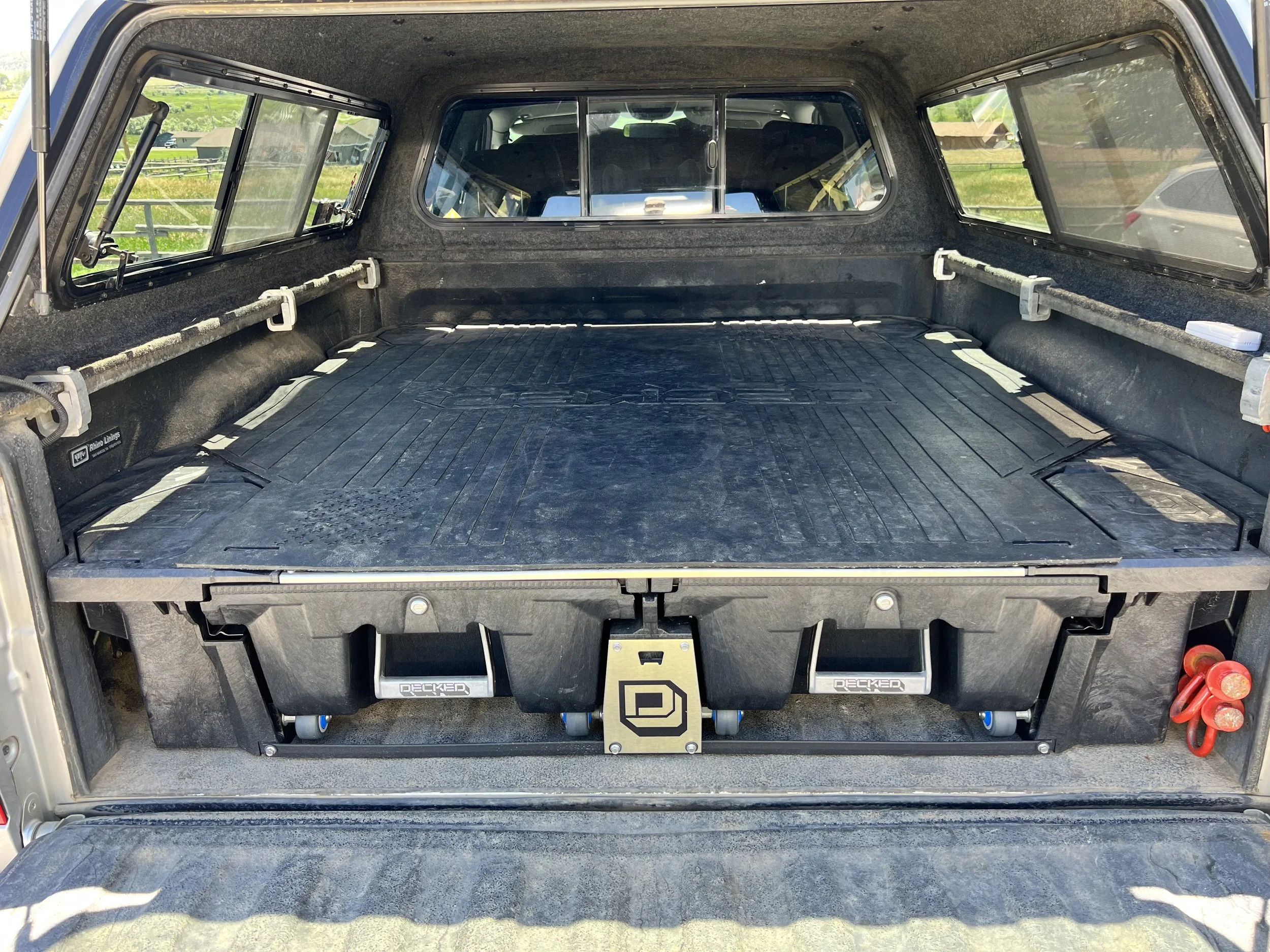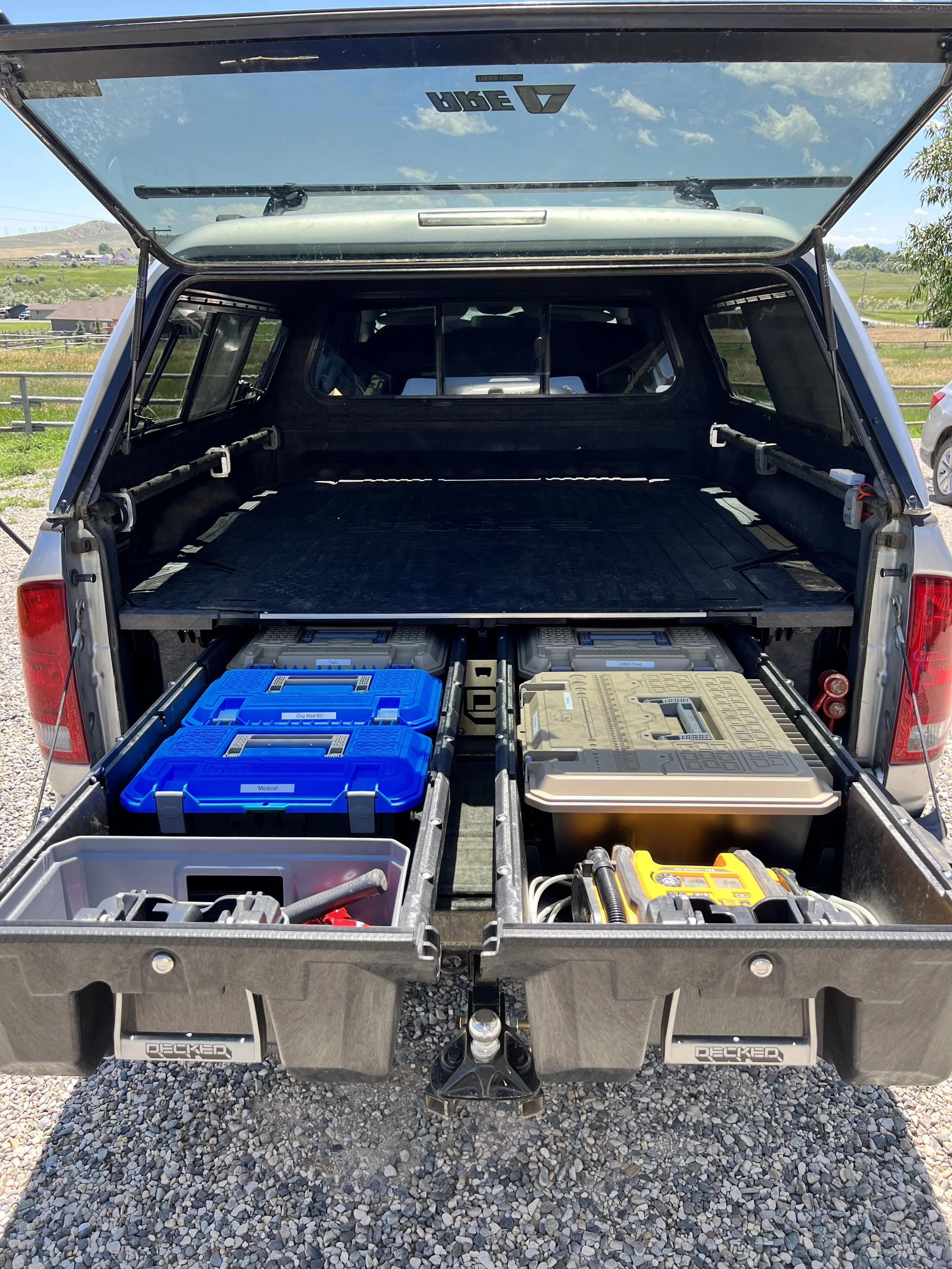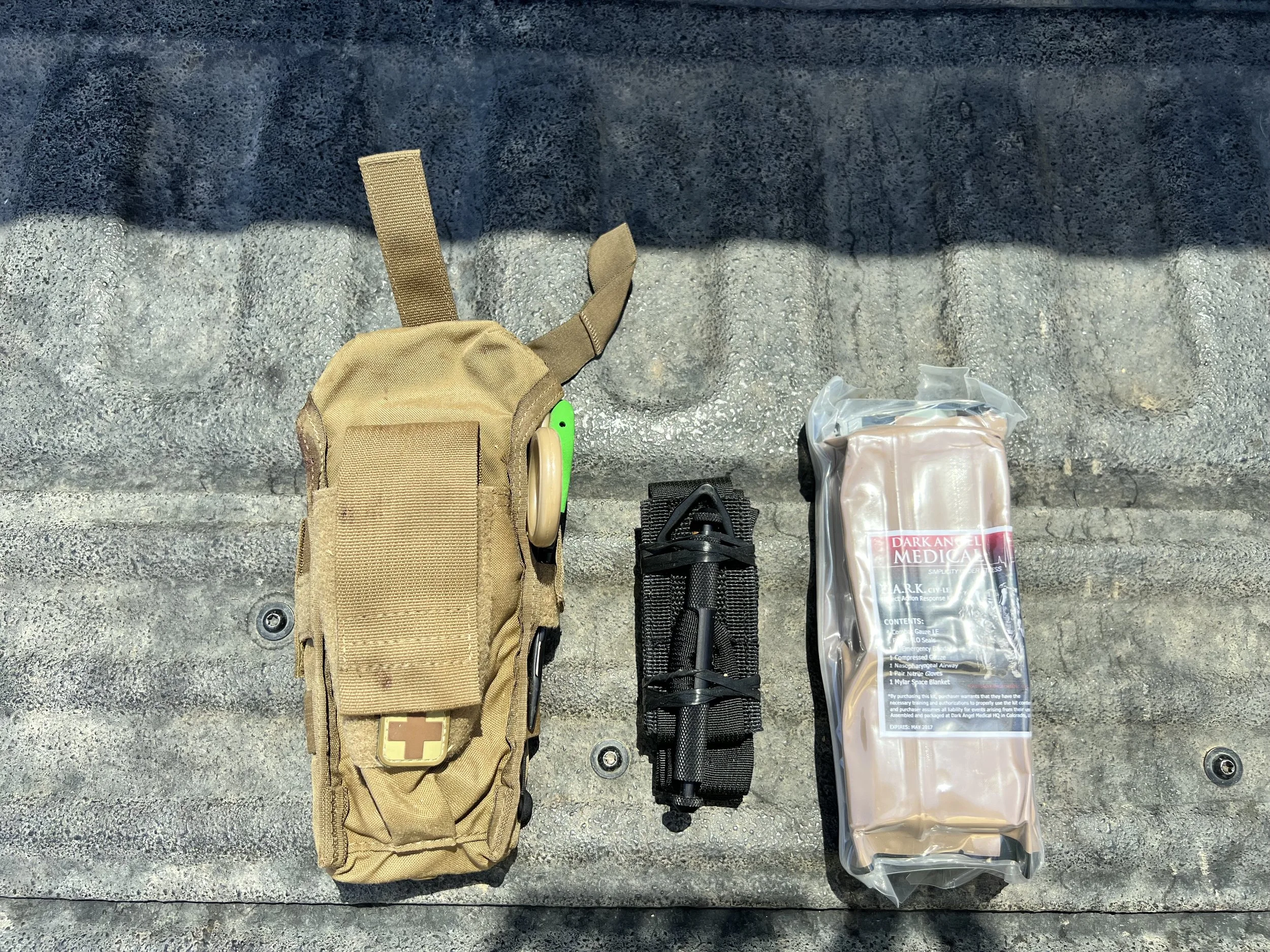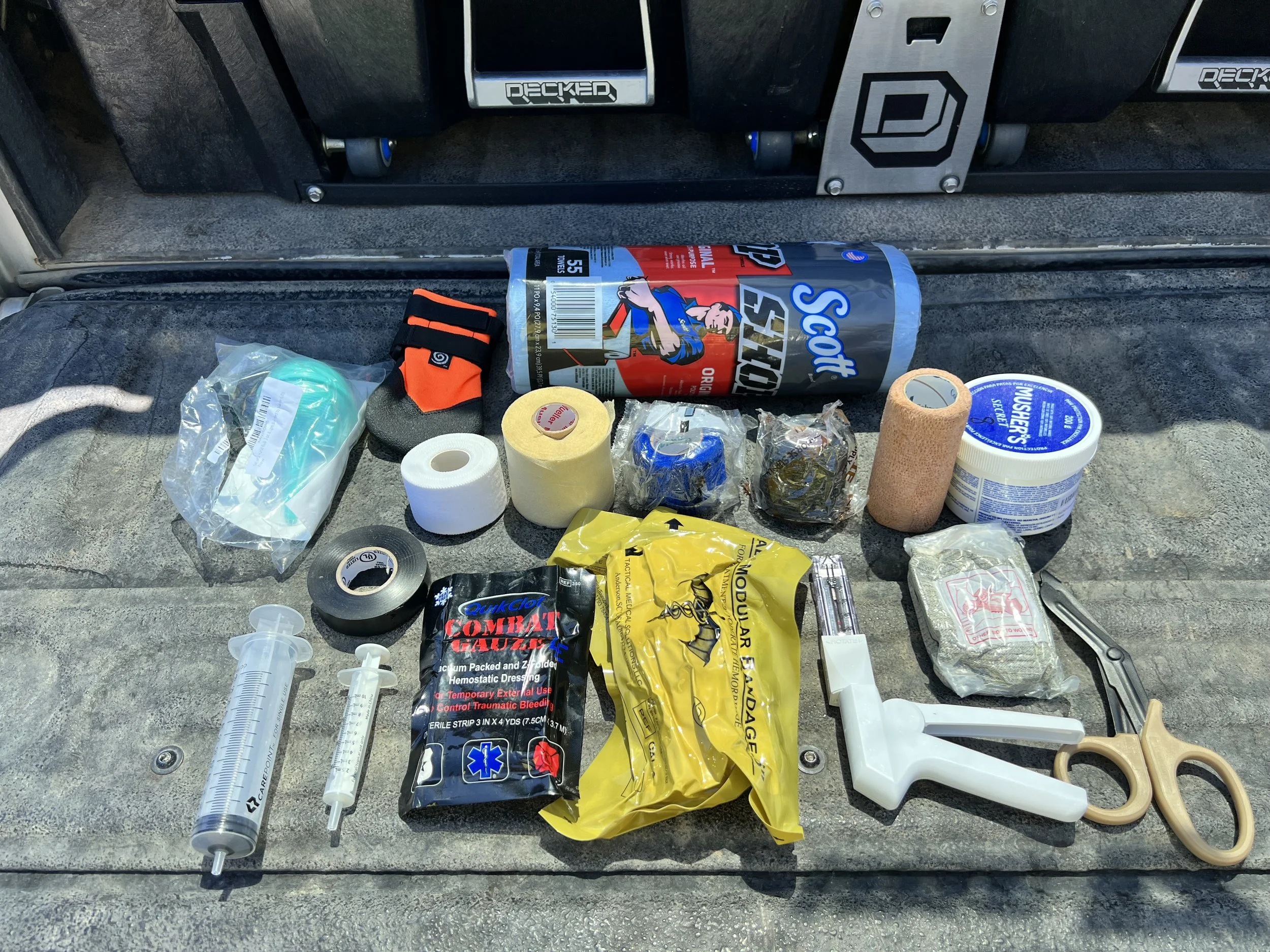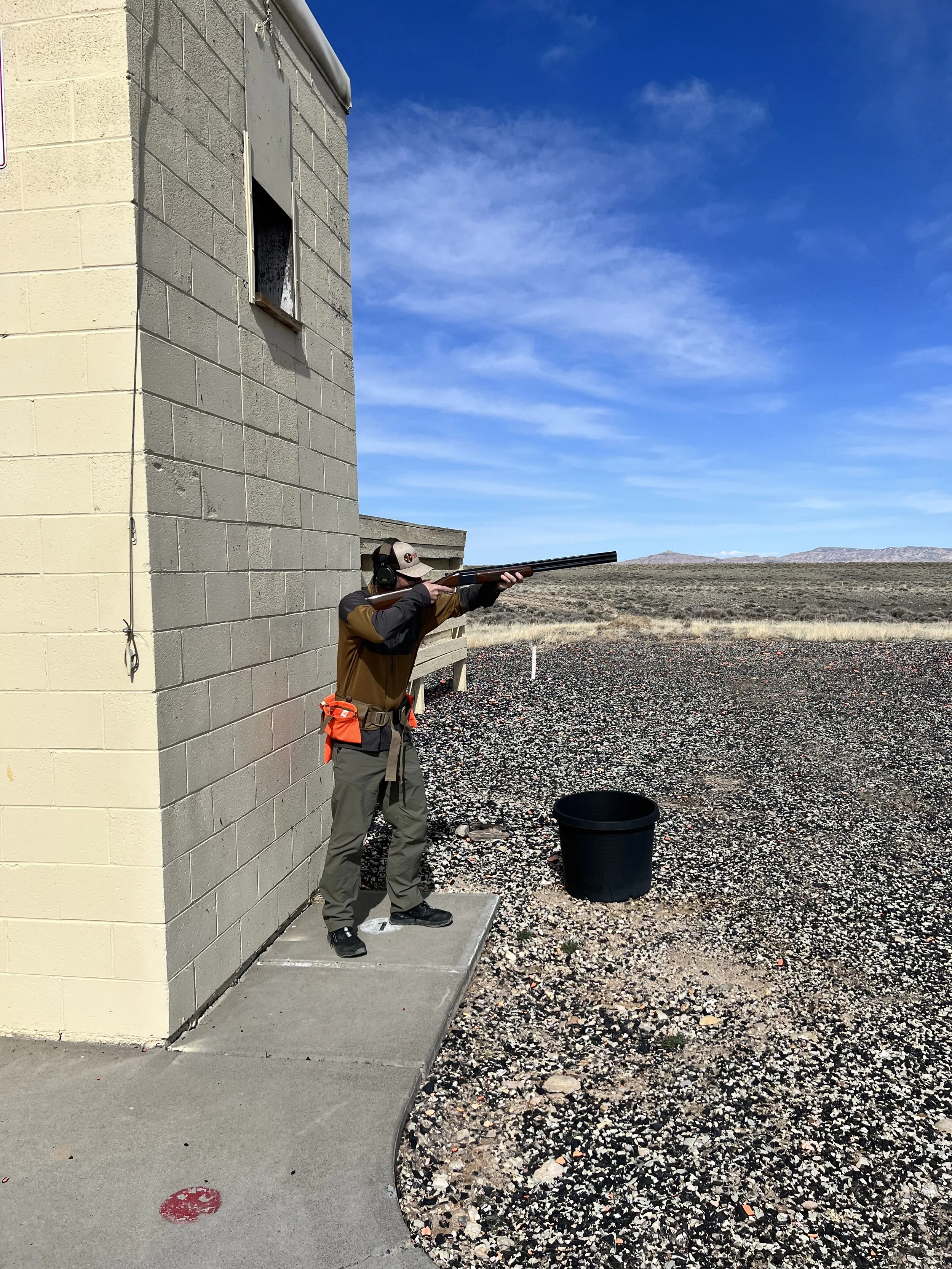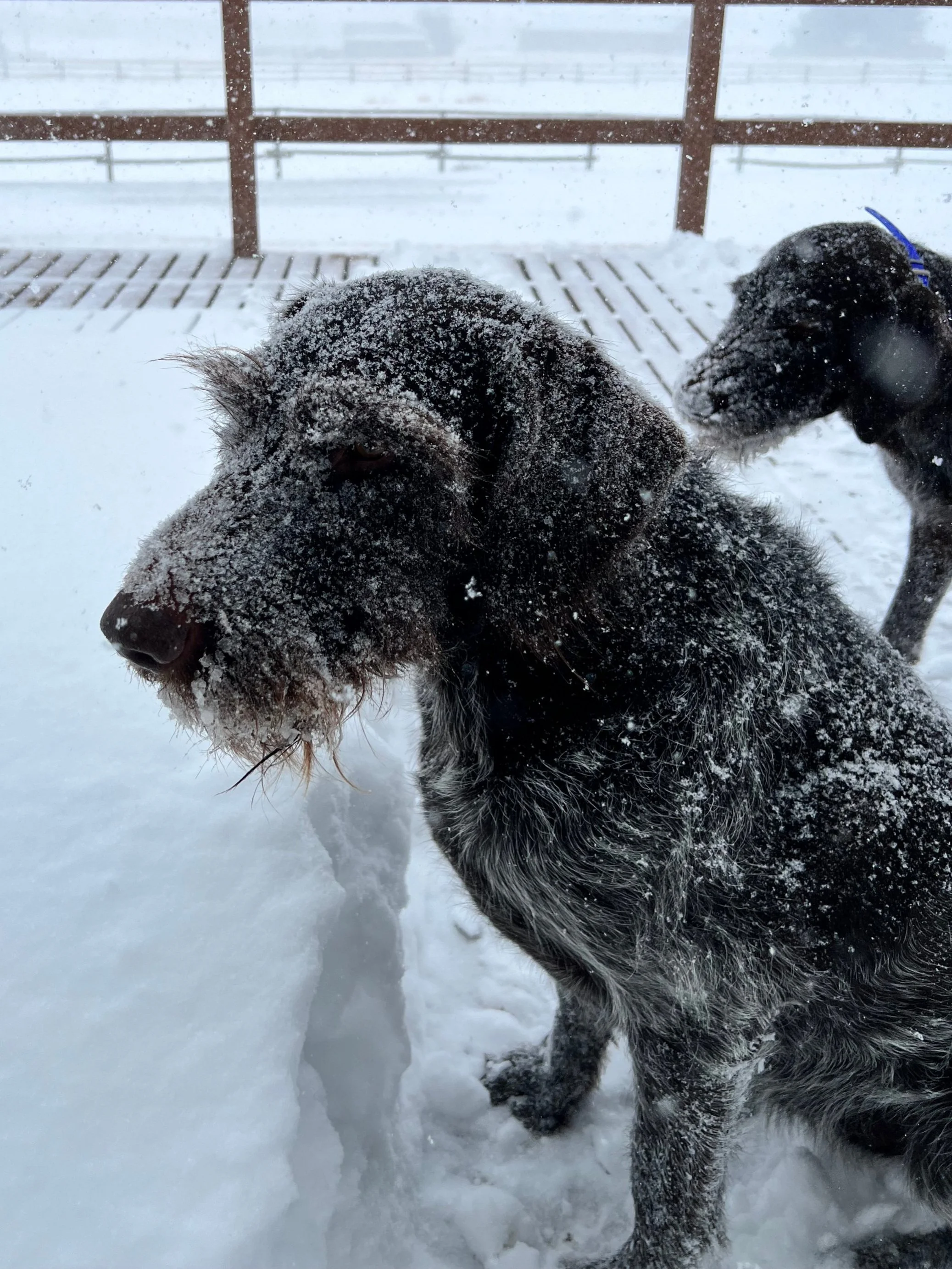Top 5 things we are working on now for a successful upland season
It’s July, before we know it September will be here, and upland season will start. After so many years in the Marine Corps, it’s hard not to follow ingrained habits such as one of our favorite leadership principles: know yourself and seek self-improvement. For our first field journal contribution, we give an inside look at the five areas we are working on now to enable a more enjoyable hunting season: dog skills, gear gaps, shooting, fitness, and hunt planning! We intend to provide more details and progress updates in future installments of “HPG on the Hunt.”
Dog skills
The cold and rain have finally let up here in Wyoming and to be honest, it’s more fun working dogs in nice weather! We have three summer training goals: conditioning for both dogs, along with refining steadiness and improving our younger dog’s whistle halt. We are at best amateur dog trainers, and are thankful to the many resources the VDD-GNA club offers to help dog owners train the needed hunting skills to our Deutsch Drahthaars (DDs). Since 2016, we have attended training days and met great people we now call friends or mentors. The knowledge gained during these events cannot be understated; the trainings provided both a good foundation and specific trouble shooting to refine the dogs’ natural abilities. The result was effective and enjoyable hunting dogs. If you plan to train your own dog, we recommend finding someone in your local area willing to help. It can be a challenging process, but it’s well worth the trouble to jump-start your dog training ability. Many breed clubs hold training days, and we believe these are valuable experiences. For those with a versatile hunting dog, another resource is the North American Versatile Hunting Dog Association (NAVHDA). At the end of the day, we have dogs because we love them and enjoy spending time with them in the field. Your dog will never be perfect but get out and have some fun together!
Gear Gaps
Probably like you, we spend a lot of time wearing our hunting gear and traveling in our vehicles to chase birds. Since we already upgraded to the High Plains Gear vest system and holsters 😉, our three priority gear upgrades are: 1) a Lathrop and Sons Custom Boot System (Rhys), 2) Decked Drawer System (truck), and 3) refreshing our medical kits. A potential bonus upgrade is an Upland Gun Company Zeus 20 gauge (Kitt) — more to follow, as an unexpected surgery required adjustments to our brilliant plans!
New Boots
So, why did I (Rhys) decide to try the Lathrop and Sons custom boot system — customer service and the opportunity to have custom foot-beds. Overall, my feet hold up well and have very few problems. Even in the Marine Corps, I only had a few major blisters at Officer Candidate School from the standard issue boots and crazy hot, wet weather! I also developed bone spurs that, with the help of a podiatrist, I figured out how to deal with over the years. Since 2017, I have enjoyed wearing Crispi Birksdal boots. I also tried a pair of Hanwag and a different model Crispi, but for me, the fit was not there. Unfortunately, time in the field is required to really know how a boot will work; I know the frustration of having two, $400 plus dollar pairs of boots that have good qualities and reviews, but just don’t fit. I thought about trying the Crispi Birksdal again, but the boot has been changed. After considering the different factors cost, time, comfort, etc, we decided the best value was to try the custom boot with specifically selected foot-beds and both pre/post sale support.
To start the process, I requested a 3d mapping kit. Once received, it was straight forward and easy to complete. I just traced both feet on the provided transfer paper and returned with the same envelope and supplied return shipping label, along with emailing requested pictures. About two weeks later, I had an initial consultation with Steve that lasted about 45 minutes. During the consult with Steve, we talked through the bone spurs, and he also brought up ankle stability. I hadn’t really considered a relationship between the two, but his points and recommendations made sense. Steve also talked to me about going a size up, to which I was hesitant. I took his advice, as 60 percent of our bird hunting is for chukar requiring steep terrain walking and side-hilling. The one size up will hopefully help in the hills! Based on Steve’s expert advice and passion to help people hunt with comfortable feet, I ordered the L&S Mountain Hunter Warm with Custom Synergy orthotics, and for the bone spurs, a right boot tongue modification. After the boots arrive, and then with a full season in them, I will give some no BS reviews!
Decked Drawer System
We spend significant time in our truck and run an A.R.E. topper. In 2020, I (Rhys) built a platform designed to support two kennels with the doors facing the truck bed’s driver side. The topper has a side open window, making the kennels easy to reach and open, without having to climb into the truck. I designed the platform high enough to fit a couple smaller totes under it to keep gear organized for longer trips. I also carried a toolbox, medical gear in two smaller plastic ammo cans, and sometimes tire chains. Over the last three years, I realized that while it worked, it wasn’t ideal. Gear organization was always a challenge, and when I needed something, it had usually ended up sliding under the platform and was then a pain to retrieve. We also plan to add a third DD pup to the family in May ‘24, so we needed a better solution that could support three kennels. The search was on.
I knew the Decked system existed but had never really spent much time looking at it. Our priority was the ability to run three dog kennels. After measuring, I found that three, large Ruff Land kennels would fit turned sideways with the doors to the driver’s side. The next priority was organization, and the Decked system’s capabilities in this area really sold me. Tools, medical supplies, dog food, pigeon launchers, tire chains, etc all have a place to go and are easy to access. I ordered (4) D-boxes, (5) cross-boxes, and locks. Our experience so far, is that the Decked customer service is outstanding. The order was shipped in several parts. The first items to show up were the boxes. Unfortunately, all cross-boxes were sent with no D-boxes. Once informed, the Decked team immediately corrected the mistake. Assembly and installation was easy due to the well written directions and straight forward assembly video, which is helpful to watch before the task. Assembly took about an hour. The attachments that hook to the existing tie downs are a very nice touch and were also easy to install. After using the Decked system for a few weeks, I am extremely impressed. The quality is actually better than I expected, and I believe it will hold up for a long time! I can carry more gear, in a much more organized fashion. The only two things I now foresee having to carry outside of the drawers during hunting, will be a dog water carrier and a cooler as needed. More detailed reviews and feedback to come as we use the Decked system this season.
Medical Kits
Our Marine Corps experience showed us how a small, lightweight medical kit can be a life saver. Get one and know how to use it! We also keep robust medical kits in our vehicles, for those just in case events. During hunting season, we add additional items to the vehicle kit to meet the specific field circumstances. Whenever possible, we select products that can be used on both us and our dogs. We have carried Dark Angel medical kits for over a decade now and used the kits twice in the field (not in life-threatening events thankfully, but they came in handy). While hunting, we carry the Direct Action Response Kit (DARK) Trauma Kit; it’s a compact, light kit that fits directly on our belts via MOLLE attachment. This med kit can cover everything up to a life threatening bleed and can be customized with available options and upgrades. We suggest upgrading two things in standard medical kits. First is the tourniquet, we really like the SOF-T, as it is one of the most robust on the market and the parts are metal. Unfortunately, we know from personal experience that sometimes tourniquets with plastic handles break at the handle. The other upgrade we make is to the shears. Dark Angel Rip Shears are heavy duty and can cut through just about anything! We have heard they can cut through snare wire, but thankfully have not tested that ourselves.
The best medical kit is one you know how to use. Seek training on how to use the items you carry. Hands on, in-person training is best, but at a minimum YouTube educate your hunting team. Remember to check your kits for expired or damaged items before the season starts! We carry: Upgraded SOF-T Tourniquet, (1) Pair HALO Vents Seals, QuickClot Combat Gauze Civilian, Nasopharyngeal Air Way, Emergency Bandage, Compressed Gauze, Nitrile Gloves, Mylar Blanket, Eye Shield, and upgraded Rip Shears. During hunting season, we also have a stapler, razors, two roles of paper towels, betadine, distilled water, multiple sizes of Kerlix, athletic tape, ear cleaner, hemostat, and a 90cc bulb syringe (Note on the Nasopharyngeal airway, only use if you have proper medical training).
Shooting
Shells, chokes, and patterns! These are sometimes overlooked aspects in the bird hunting community. We have had great experiences with Federal Prairie Storm and Fiocchi Golden Pheasant shells; they pattern extremely well out of our guns and chokes! For North and South Dakota pheasant we run 12ga and 20ga 3” #4s. We cleanly hit more birds, and on those high wind days, the shot moves less. We all know the wind can be a bit brutal out there! We load and run a combination of #6s and #7.5s for chukar, quail, and grouse. We load all copper or zinc plated shot, and our load development is guided by a few different factors — the most important being reliable load data. We use Ballistic Products, Lyman reloading manuals/handbooks, the Alliant Powder and Hodgdon Powder websites, and follow them accordingly; Müller Choke Tube information to helps guide our load development.
Anytime we get a new shotgun, the first thing we do is hit the patterning board. We use both proven factory and reloaded ammunition. If the shots do not pattern well with the factory chokes, the first thing we try are new Müller Waterfowl/Hunting chokes. Nine times out of ten this change has solved any patterning issue. We use a Ponseness Warren Duomatic 375 to load our hunting shells and MEC 9000 and Grabber progressive presses for high volume range shells. We will have another blog that goes in-depth on the factory and reloaded ammunition we use, why we use certain shot sizes, and why we keep our ammunition in a certain velocity range. Stay tuned!
We know we are preaching to the choir when we say practice, practice, and practice, but is there really too much time at the range — plus it is a lot of fun! Cody, WY has an amazing shooting complex with multiple skeet and trap ranges as well as 5-stand and sporting clays. We spend 90 percent of our time at the skeet range. We love that most of the shots you will see in the field are thrown on the skeet range, it is relatively quick to shoot a round, and our range, like many today, can throw on delay — so you can shoot solo. When we have the time, we like to shoot 5-stand and sporting clays and enjoy few rounds of trap each year. The challenge of the various shoots, a bit of competition, and spending time with friends at the range makes practice more enjoyable. We hope you can make time to check out and maybe invest in your local range.
Personal Fitness
To be honest, you don’t have to be in shape to enjoy a single weekend bird hunt. Of course, it would make your life easier and impress your hunting partners if you were though! If you do plan to spend multiple days in the field, being physically ready for a full September - February upland season can make a significant difference in your experience. For example, those 12 mi days chasing chukar in nasty terrain are going to be a pleasurable challenge verses a humbling experience that has you questioning your intestinal fortitude. Over the years we now understand that for us, personal fitness has three components: physical training, nutrition, and resilience/longevity (trendy buzzwords, catch all😉).
First, let’s talk physical training. In 2014, we started training at a Crossfit gym and experienced the results of combining strength training with high intensity interval training (HIIT), with both changes in bloodwork and in performance over a hunting season. As we learned more about what worked best for our family and travel schedule, we have moved to alternatives that provided HIIT workouts and more specific strength and assistance exercises tailored to our activities. Resources like the Mountain Tactical Institute and Fuel Your Potential, who provides are current training programing, help to make the most of limited time. We are blessed with an amazing workout set-up here in Cody, WY, The Barbell Club. We also enjoy long, quiet, hilly weekend walks with some weight in our Kifaru pack and the ever evolving toddler in some sort of carrying system (current). While it is hard to make time, consistency is the key we believe helps us to be more capable today than we were yesterday.
A constant challenge for us, like maybe some of you, is nutrition. For almost ten years now, we have found a paleo-ish diet helps us to feel our best. We will be the first to admit that Mexican food is our downfall. For us, there is nothing quite like a fully stuffed burrito or chips and salsa to improve the day! For years, we also enjoyed “the ish” by including butter and cheese. Unfortunately, several sinus infections last winter encouraged us to follow-up with an ENT, who recommended cutting out all dairy due to its tendency to increase inflammation and mucus production. In personal testing, using a similar method as the Whole 30 Program, we cut out dairy completely for several weeks and then added back one product at a time to find out how our bodies responded. Unfortunately, most of the dairy we loved does cause a reaction. We now understand our choices better and can consciously decide if we want an indulgence, knowing the consequences. A trusted resource that has introduced us to new ideas and helped in translating scientific data into usable recommendations is Found my Fitness with Dr. Rhonda Kirkpatrick. We are currently testing how time restricted eating affects us and learning about fasting — more on that in another post. May brought spring flowers and an unplanned surgery that included some broad-spectrum antibiotics, resulting in a digestion system in need of repair (Kitt). We plan to have a more detailed update on that recovery process prior to New Year resolution time! The final nutrition component we want to highlight is hydration. Like most people, we grew up thinking Gatorade was the best in sports nutrition, until the movie “Waterboy” reminded us H2O was pretty good too 😁. These days, we follow the cutting edge research on electrolytes. The LMNT website explains new research available on salt best here, and the bottom line is that we feel better keeping our water and our bodies salty! Check them out! They even provide a make yourself recipes.
The last component is a bit of a clean-up category. When we talk about resiliency/longevity, we include components like sleep, mobility and movement patterns, and stress management. These are all the areas we wish we dedicated more time to and were more diligent about! Resources we love: Doc Parsley on sleep, The Ready State (formerly Mobility WOD) or Pliability (formerly ROMWOD) and our local physical/occupational therapists for mobility/movement, and applications like Abide or Soulspace to provide some “quiet time.” We also try to keep calm and stay informed via email news from The Pour Over (TPO) and 1440’s Daily Digest. Our top priority in this category is sleep, which for us requires stress management and a cooperative toddler! The stars do not always align, but we continue the battle!
Location Planning
If you don’t plan, it won’t happen — or you will be playing catch-up! We already have hunting days on the calendar for home (Wyoming), Wisconsin, Minnesota, North Dakota, South Dakota, Montana, and Arizona. September 1st we will be in the Wyoming mountains chasing Blue Grouse. Depending on how the Doves are flying in North Dakota, we will head to a friend’s farm for a (3) day dove shoot. Then to Wisconsin for Grouse Camp 2023 with a quick return home for the last few Sage Grouse days. In October, we head back to North Dakota and then meet other DD buddies for a few days in South Dakota. Most of November and December will be spent chasing Chukar in the Big Horn Basin, with a few duck hunts on the river at home. Hoping to finalize dates to meet up with friends and chase some birds in Idaho as well. Planning our escape from the Wyo deep freeze in January and February by chasing quail in Arizona and voyaging to Hawaii to visit Marine Corps friends stationed there. We are looking into an island bird hunt to keep our fitness up, while we are daily enjoying some of the world’s best coffee and chocolate! This list is not to brag about how much time we plan to spend hunting, but provides an example of the framework we set out to keep organized as we continue detailed planning using onX Hunt and local guide resources. Stay tuned for more details on each adventure in future blog entries.
We always welcome feedback, questions, and ideas - leave comments below or reach out via email or phone/txt (307) 696-9130. Thanks for giving us your time and making it to the end — Happy Hunting!


